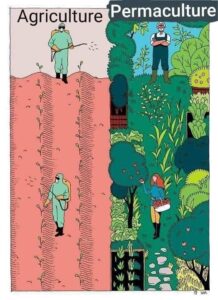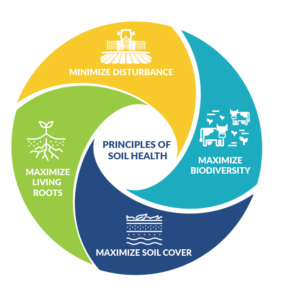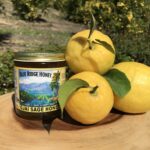What are Organic Farms?

“Organic” is a labeling term that indicates that the food or other agricultural product has been produced on organic farms according to the USDA organic standards.
The National Organic Program (NOP) develops the rules and regulations for the production, handling, labeling, and enforcement of all USDA organic products.
The national standard states that:
- Organic food must be produced without the use of conventional pesticides, petroleum-based fertilizers, sewage-sludge-based fertilizers, herbicides, genetic engineering (biotechnology), antibiotics, growth hormones, or irradiation.
- Animals raised on an organic operation must meet animal health welfare standards, not be fed antibiotics or growth hormones, be fed 100% organic feed, and must be provided access to the outdoors.
- Land must have no prohibited substances applied to it for at least three years before the harvest of an organic crop.
- Organic production systems do not use genetically modified (GM) seed, synthetic pesticides or fertilizers.
- An organic farmer can’t plant GMO seeds, an organic cow can’t eat GMO alfalfa or corn, and an organic soup producer can’t use any GMO ingredients.
- No synthetic fertilizers, sewage sludge, irradiation, and genetic engineering are ever used on an organic farm.
Some of the Organic farms are not “Certified Organic,” which simply means they didn’t go through a formal (expensive and time-consuming) certification process. “Certified Organic” means that an accredited third-party verified that the farm is following Organic practices.
What are Beyond Organic Farms?
Notice that USDA Organic label refers only to the chemicals applied (the inputs). It does not give any indication of the processes, sustainability, or ethics of the agricultural practices used in the process.
Beyond Organic farming goes beyond the minimum required to get a “USDA Organic” certification.
The distinction of “Beyond Organic” is not regulated by any certification organization but became necessary when large agricultural businesses entered the market motivated by the increased demand for organic products.
Large profit-above-all-else-oriented businesses do the minimum necessary to get the organic certification. They are technically organic farms because they utilize allowable chemicals but otherwise they rely on industrial mode of agriculture.
On the other hand,
Beyond Organic farms intentionally focus on developing and incorporating production practices with environmental benefits such as water management practices, no-till or minimum tillage, habitat maintenance for beneficial insects and vertebrates, and biological pest control.
These ecologically protective practices contribute to enhanced ecosystem services and benefit water quality, soil health, and biodiversity.
Beyond Organic farms practice ecosystem-healing farming which goes by many names such as regenerative, holistic, conservation, biodynamic agriculture, agroecology, permaculture, agroforestry and more depending on the specific microclimate and the biological variables involved.
In a nutshell, [Beyond] Organic Farming is not just business-as-usual industrial farming, but farming like the Earth matters.1.
How are Beyond Organic Farms Different from “Conventional” Agriculture Operations?

“Conventional” farmers first use chemical herbicides to fight weeds which produces an undesirable side effect of killing a lot of microbes and other living organisms in the soil, thus making soil unhealthy or dead. Then they compensate by adding synthetic fertilizers in order to return some critical nutrients to their soils.
This method of agriculture becomes a spiral with a host of unintended consequences, including water pollution, soil erosion, and loss of essential biodiversity, among others.
“Conventional” farming typically uses minimal crop rotations, growing the same single crop year after year on the same land. This practice, known as mono cropping causes the depletion of nutrients and minerals.
In order to continue growing crops in this depleted soil, nutrients and minerals must be added back in the form of hydrocarbon based fertilizers and mined minerals such as phosphate.
“Conventional” farming is dependent on earth-based non-renewable resources. Monocultures and the resulting poor health open the way for infestations of insects, diseases and weeds.
The lack of biodiversity requires synthetic pesticides and herbicides to be used, further destroying the national soil biology.
Of course, there is nothing “conventional” or “traditional” about conventional agriculture. It is really a code word for “industrialized” and “chemically-treated.” Similarly, there is nothing “alternative” about organic agriculture that used to be the norm for millennia.
How Do Beyond Organic Farms Heal the Environment?

Most people don’t realize that Beyond Organic farming practices and Organic food that they provide for us are not only better for our immediate physical health and well-being but also protect and heal our environment and mitigate climate change.
Beyond Organic farms benefit us in at least the following ways:
- Healthy Food
- Healthy Soil
- Healthy Water
- Healthy Plants
- Improved Biodiversity
- Healthy Environments
- Crop Productivity
- Reduced Waste
- Reduced Greenhouse Gases
- Increased Carbon Sequestration
Foundation of Beyond Organic Production – Healthy Soil:
The foundation of why beyond organic farms help protect the environment revolves around creating, promoting, and protecting the health of the soil.
According to United States Department of Agriculture:
“Soil health is defined as the continued capacity of soil to function as a vital living ecosystem that sustains plants, animals, and humans.”
Healthy soil gives us clean air and water, bountiful crops and forests, productive grazing lands, diverse wildlife, and beautiful landscapes.
Healthy soil does all this by performing five essential functions:
- Regulating water – Soil helps control where rain, snowmelt, and irrigation water goes. Water flows over the land or into and through the soil.
- Sustaining plant and animal life – The diversity and productivity of living things depends on soil.
- Filtering and buffering potential pollutants – The minerals and microbes in soil are responsible for filtering, buffering, degrading, immobilizing, and detoxifying organic and inorganic materials, including industrial and municipal by-products and atmospheric deposits.
- Cycling nutrients – Carbon, nitrogen, phosphorus, and many other nutrients are stored, transformed, and cycled in the soil.
- Providing physical stability and support – Soil structure provides a medium for plant roots. Soils also provide support for human structures and protection for archeological treasures.
Primarily what makes soil healthy is its biological diversity – billions of bacteria, fungi, and other microbes that are the foundation of an symbiotic ecosystem.
“When artificial pesticides, herbicides, insecticides, are fungicides are used, all the beautiful biodiversity perishes, leaving behind barren land devoid of any natural nutrients, and chemicals that get soaked into our waterways and are poisonous to our bodies and our environment.”
By farming using soil health principles and systems that include no-till, cover cropping, and diverse rotations, more and more farmers are increasing their soil’s organic matter and improving microbial activity.
As a result, beyond organic farmers are sequestering more carbon, increasing water infiltration, improving wildlife and pollinator habitat.”
Healthy soils have good structure (tilth), which allows them to absorb and hold moisture, drain well, maintain adequate aeration, and foster deep, healthy crop root systems.
“Healthy soils sustain crops through dry spells, require less irrigation water, and undergo less ponding, runoff, and erosion during heavy rains.
Four Guiding Principles to Support Healthy Soil:

The Natural Resources Conservation Service (NRCS) has identified four guiding principles that support healthy soils and provide the foundation for a resilient farm system:
Guiding Principles of Healthy Soil:
- minimize soil disturbance,
- maximize biodiversity,
- keep soil covered,
- maintain living roots.
The USDA National Organic Standards require certified producers to implement crop rotation, cover cropping, tillage, nutrient management, and other practices that improve and maintain the physical, chemical, and biological condition of the soil.
An Interactive Exploration of Soil Health and How to Improve It.
Organic Farming Research Foundation states that organic farms use biological fertilizer inputs and management practices such as cover cropping and crop rotation to improve soil quality and build organic soil matter.
Benefits of Biological Fertilizer:
Using biological forms of fertilizer such as compost, animal manures, and legume cover crops, builds soil organic matter, even when routine tillage is used for weed control.
Building soil organic matter increases soil water retention and nurtures more active soil microbial communities that retain nitrogen in the soil longer and transform it into non-leachable gaseous forms.
Organic biological fertilizer sources release their nutrients slowly over time, providing more opportunity for the nitrogen to be digested by soil organisms and taken up by crops before leaching below the root zone.
Increased soil organic matter in the soil leads to tighter nutrient cycling and greater water holding capability in organically managed soils, with the result that nitrate leaching from groundwater is about half that of conventionally farmed soils.
By increasing the amount of organic matter in the soil, organic farms enhance the soil’s ability to absorb water, reducing the impacts of drought and flooding. Improving soil organic matter also helps it to absorb and store carbon and other nutrients need to grow healthy crops, which, in turn, are better able to resist insects and diseases.
Benefits of Cover Cropping:
According to Sustainable Agriculture Research and Education (SARE), a cover crop is a plant that is used primarily to slow erosion, improve soil health, enhance water availability, smother weeds, help control pests and diseases, increase biodiversity and bring a host of other benefits to organic farms.
Rodale Institute describes that cover crops’ primary job is to improve the soil. Cover crops get planted in fields that would otherwise be bare to protect the soil from erosion and nutrient loss. They are not planted to be harvested but for the sole purpose of helping to return nutrients to the soil. Cover crops are rolled by the roller crimper to create a nutritious weed-suppressing mulch.
Cover crops are selected for their unique ability to “fix” nutrients like nitrogen from the atmosphere and return them to the soil, making them an indispensable tool in maintaining and increasing soil fertility without chemical use. Examples of cover crops are Austrian winter peas, alfalfa, rye, mustard, oats, and buckwheat, among others.
Cover crops also keep something green and growing during off-season, helping farmers sequester more carbon to fight greenhouse gas emissions.
Cover crops have also been shown to increase crop yields, break through a plow pan, add organic matter to the soil, improve crop diversity on farms and attract pollinators.
There is an increasing body of evidence that growing cover crops increases resilience in the face of erratic and increasingly intensive rainfall, as well as under drought conditions. Cover crops help when it doesn’t rain, they help when it rains, and they help when it pours!
How Do Beyond Organic Farms Combat Climate Change?
Did you know that beyond organic farms enhance carbon sequestration, build climate resiliency, and release fewer greenhouse gases?
The reason for this is that beyond organic farms use agricultural methods that integrate cultural, biological, and mechanical practices that foster cycling of resources, promote ecological balance, and conserve biodiversity.
Let’s dive deeper and see how this level of influence can be achieved simply by using beyond organic farming practices.
According to The United States Geological Survey (USGS), Carbon Dioxide is the most commonly produced greenhouse gas.
Carbon sequestration is the process of capturing and storing atmospheric carbon dioxide. It is one method of reducing the amount of carbon dioxide in the atmosphere with the goal of reducing global climate change.
Globally, soils are estimated to contain >8,580 gigatons of organic carbon, about ten times the amount in the atmosphere and much more than in vegetation. Soil carbon sequestration means maximizing atmospheric carbon dioxide removal and minimizing soil carbon losses.
All crops absorb CO2 during growth and release it after harvest. For soil carbon sequestration to occur, all of the soil organic carbon sequestered must originate from the atmospheric carbon pool and be transferred into soil organic matter through plants, plant residues, microbial residues, and other organic solids.
The goal of agricultural carbon removal is to use the crop and its relation to the carbon cycle to permanently sequester carbon within the soil. This is done by selecting farming methods that return biomass to the soil and enhance the conditions in which the carbon within the plants will be reduced to its elemental nature and stored in a stable state.
The Problem:
“Conventional” agriculture as practiced across most of the world plays a significant role in exacerbating the climate change problem, because it is a net producer of greenhouse gas emissions both directly through conventional industrial farming practices, and indirectly through land-use change and the greater food system.
“Conventional” agriculture production alone accounts for around 10% of annual greenhouse gas emissions. The whole food system at large, including fertilizer and pesticide manufacture, processing, transportation, refrigeration and waste disposal, accounts for 30% or more of total annual emissions.
Some estimates show that accelerated soil erosion may be the second largest source of anthropogenic emissions of greenhouse gases. The United Nations International Panel on Climate Change identified that agricultural activities are responsible for nearly a quarter of global greenhouse gas emissions.
Widespread industrialization of farming in the mid-20th century, contemporary agricultural practices, such as synthetic fertilizers, pesticides, intensive tillage, monocropping, and yield-based management systems, accelerated the depletion of soil carbon stocks.
The solution:
Fortunately, if the way we do farming is contributing to the problem of accelerating climate change, it can also be used as a potential solution.
Soil organic matter contains three to four times as much carbon as either the atmosphere or terrestrial vegetation. Even small changes in soil carbon can lead to large changes in the atmospheric concentration of carbon dioxide.
Agricultural methods for accomplishing this goal coincide with organic farming practices. Reduced tillage, crop diversification, cover cropping, organic amendments, and sound nutrient management can enhance carbon sequestration in the soil and build climate resiliency in organic agricultural systems.
Shifting both crop and pasture management globally to regenerative systems is a powerful combination that could drawdown more than 100% of annual emissions, pulling carbon from the atmosphere and storing it in the soil.1
Organic farms do not use synthetic pesticides and fertilizers, one of the primary contributors of greenhouse gases.
Healthy soils help crops obtain nitrogen, phosphorus, and other nutrients from organic soil organic matter. This reduces the need for fertilizers that can threaten water quality and minimizes the release of greenhouse gases from soils.
Recent international agricultural reports recognize organic agriculture as an innovative farming system that balances multiple sustainability goals and will be of increasing importance in global food and ecosystem security.
Organic agriculture can be a part of the solution and help tackle climate change through its ability to reduce greenhouse gas emissions, store away huge amounts of carbon, and enable farmers to be resilient in an evolving climate.
Join the Conversation:
What are your thoughts, experiences, and challenges with Organic Farms?
We would love to hear from you.
-

Organic Sage Leaves – Fresh Wildcrafted Purple Sage from California – Unwaxed Unsprayed Chemical-Free Veganic Non-GMO
$5.99 – $49.99 — available on subscription -

Organic Persimmons – Maru – “Chocolate Persimmon” – Unwaxed Unsprayed Chemical-Free Veganic Non-GMO – 4lbs
$24.99 — available on subscription -

Get Well Soon Gift Box – Organic Lemons and Honey from California Farm
$24.99 — available on subscription -

Extra Virgin Olive Oil – California Gold – Organically Grown and Cold Pressed on a Family Farm in California – 500ml
$14.99 — available on subscription
- Jeff Moyer, Andrew Smith, PhD, Yichao Rui, PhD, Jennifer Hayden, PhD, Regenerative Agriculture and the Soil Solution, Rodale Institute, 2020 [↩] [↩]

